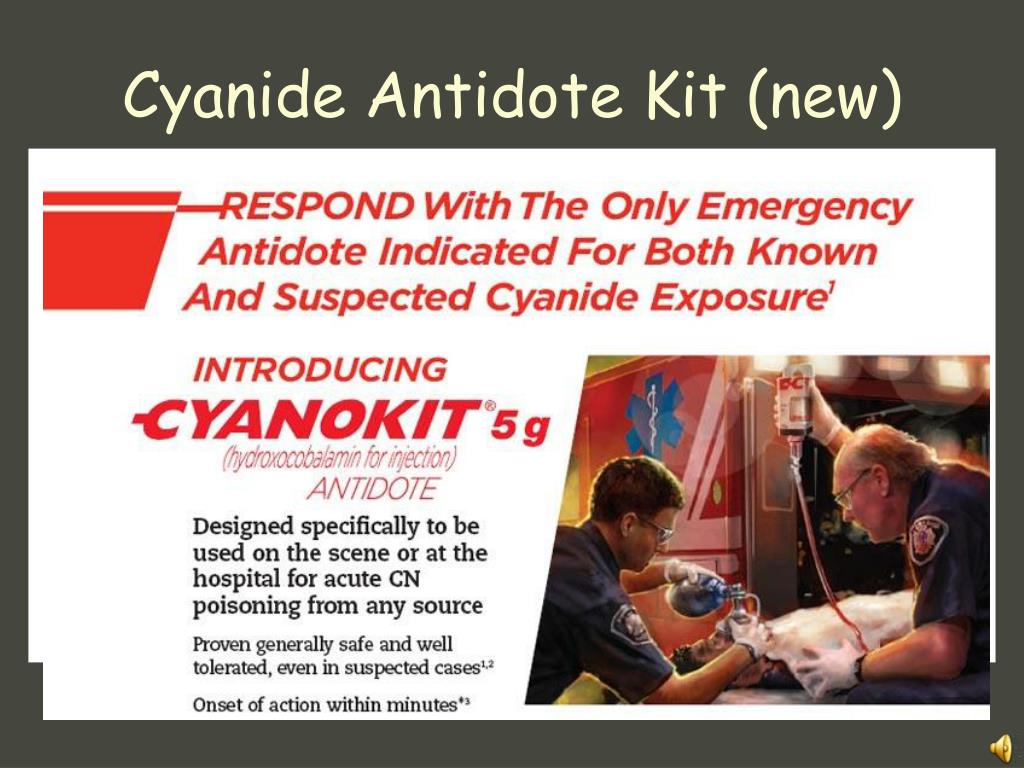
Workers using cyanide need preplacement and annual medical exams. Proper use and maintenance of protective equipment is essential. Workers must carefully follow good hygienic practices, including no eating, drinking, or smoking in workplace. Keep in a tightly closed container, stored in a cool, dry, ventilated area. Moderate cyanide exposures need be treated only by supportive measures such as bed rest and oxygen. Cyanocabalamin (B12), 1 mg intramuscularly, may speed recovery. If signs of cyanide poisoning persist or reappear, repeat nitrite and thiosulfate injections 1 hour later in 1/2 the original doses. If exposure was severe, watch victim for 24-48 hours. Give victim oxygen and keep under observation. If patient does not respond to amyl nitrite, inject intravenously with 10mL of a 3% solution of sodium nitrite at a rate of not more than 2.5 to 5 mL per minute.Once nitrite administration is complete, follow directly with 50 mL of a 25% solution of sodium thiosulfate at the same rate by the same route. Immediately flush eyes with plenty of water for at least 15 minutes, lifting lower and upper eyelids occasionally. Administer antidote kit and oxygen per preplanned instructions if symptoms occur.
#Poison antidote kit skin
Immediately flush skin with plenty of water for at least 15 minutes while removing contaminated clothing and shoes. Do not induce vomiting as it could interfere with resuscitator use. Never give anything by mouth to an unconscious person. If the patient is conscious, immediately give the patient activated charcoal slurry. If ingested, antidote kit and oxygen should be administered per above. Do not give mouth to mouth resuscitation. Administer antidote kit and oxygen per pre-planned instructions if symptoms occur. If not breathing, give oxygen and amyl nitrite immediately by means of a positive pressure respirator (artificial respiration). If consciousness is impaired (non-responsiveness, slurred speech, confusion, drowsiness) or the patient is unconscious but breathing, give oxygen and amyl nitrite by means of a respirator. If conscious but symptoms (nausea, difficult breathing, dizziness, etc.) are evident, give oxygen. A new amyl nitrite ampule should be used every 3 minutes. Allow victim to inhale amyl nitrite for 15-30 seconds per minute until sodium nitrite and sodium thiosulfate can be administered intravenously (see Note to Physician). Oxygen and amyl nitrite can be given by a first responder before medical help arrives. Actions to be taken in case of cyanide poisoning should be planned and practiced before beginning work with cyanides. A cyanide antidote kit (amyl nitrite, sodium nitrite and sodium thiosulfate) should be available in any cyanide work area. IN CASE OF CYANIDE POISONING, start first aid treatment immediately, then get medical attention. Those with history of central nervous system, thyroid, skin, heart or lung diseases may be more susceptible to the effects of this substance. Workers using cyanides should have a preplacement and periodic medical exam. Prolonged or repeated skin exposure may cause a "cyanide" rash and nasal sores. Symptoms may include redness, pain, blurred vision, and eye damage. May be absorbed through the skin, with symptoms similar to those noted for inhalation.Ĭorrosive. Solutions are corrosive to the skin and eyes, and may cause deep ulcers which heal slowly. Other symptoms may be similar to those noted for inhalation exposure.Ĭorrosive.

Bitter almonds odor may be noted on the breath or vomitus. Smaller but still lethal doses may prolong the illness for one or more hours. Larger doses may produce sudden loss of consciousness and prompt death from respiratory arrest. Highly Toxic! Corrosive to the gastro-intestinal tract with burning in the mouth and esophagus, and abdominal pain. May cause headache, weakness, dizziness, labored breathing nausea and vomiting, which can be followed by weak and irregular heart beat, unconsciousness, convulsions, coma and death. The substance inhibits cellular respiration and may cause blood, central nervous system, and thyroid changes. Cyanosis (blue discoloration of the skin) tends to be associated with severe cyanide poisonings.Ĭorrosive to the respiratory tract. Reddening of the eyes and pupil dilation are symptoms of cyanide poisoning. However, if a physical injury or lack of oxygen is involved, the skin color may be bluish. In most cases, cyanide poisoning causes a deceptively healthy pink to red skin color. Lab Protective Equip: GOGGLES & SHIELD LAB COAT & APRON VENT HOOD PROPER GLOVES SAF-T-DATA (tm) Ratings (Provided here for your convenience) AFFECTS BLOOD, CARDIOVASCULAR SYSTEM, CENTRAL NERVOUS SYSTEM AND THYROID. CAUSES BURNS TO SKIN, EYES, AND RESPIRATORY TRACT. CONTACT WITH ACIDS LIBERATES POISONOUS GAS. DANGER! MAY BE FATAL IF SWALLOWED, INHALED OR ABSORBED THROUGH SKIN.


 0 kommentar(er)
0 kommentar(er)
